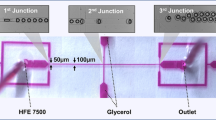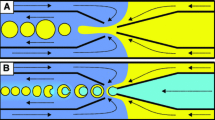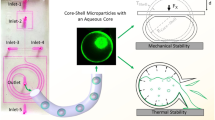Abstract
This study introduces an innovative method aimed at achieving exceptional stability in emulsions. The primary focus is on re-emulsifying precisely controlled and uniform initial single emulsions, generated by microfluidic devices, to produce single-core double emulsions and core–shell microparticles. Departing from traditional approaches, our method employs a unique combination of advanced Two-level fractional factorial design and numerical simulation. These tools are utilized to discern and optimize critical parameters necessary for the formation of highly monodispersed stable single emulsions and their subsequent transformation into double emulsions. Correlations are established to estimate the size and stability of the primary single emulsion based on immiscible phase flow rate ratio and surfactant concentration. These correlations provide a comprehensive understanding that facilitates the intentional development of desired water-in-oil emulsions. The proposed microfluidic paradigm shows promise for the controlled and efficient production of single-core double emulsions, with broad applications in Pharmaceuticals, Food, and Cosmetics.
















Similar content being viewed by others
Availability of data and materials
The datasets generated during and/or analyzed during the current study are available from the corresponding author upon reasonable request. The data that support the findings of this study are available from the corresponding author upon reasonable request.
References
Abdulredha MM, Hussain SA, Abdullah LC (2019) Separation emulsion via non-ionic surfactant: an optimization. Processes 7(6):382
Ait-Amir B, Pougnet P, El Hami A (2020) Meta-model development. In: Embedded Mechatronic Systems 2, pp. 157–187. Elsevier
Baret J-C, Kleinschmidt F, El Harrak A, Griffiths AD (2009) Kinetic aspects of emulsion stabilization by surfactants: a microfluidic analysis. Langmuir 25(11):6088–6093
BenJemaa M, Rahali FZ, Falleh H, Beji-Serairi R, Megdiche-Ksouri W, Hamrouni I, Hammami M, Nehme R, Pereira RB, Andrés S et al (2022) Essential oil stabilisation by response surface methodology (rsm): nanoemulsion formulation, physicochemical, microbiological, and sensory investigations. Molecules 27(21):7330
Bibette J, Morse D, Witten T, Weitz D (1992) Stability criteria for emulsions. Phys Rev Lett 69(16):2439
Brackbill JU, Kothe DB, Zemach C (1992) A continuum method for modeling surface tension. J Comput Phys 100(2):335–354
Chacon Orellana LA, Baret J-C (2019) Rapid stabilization of droplets by particles in microfluidics: role of droplet formation. Chem Syst Chem 1(1–2):16–24
Chagot L, Quilodrán-Casas C, Kalli M, Kovalchuk NM, Simmons MJ, Matar OK, Arcucci R, Angeli P (2022) Surfactant-laden droplet size prediction in a flow-focusing microchannel: a data-driven approach. Lab Chip 22(20):3848–3859
Chatterjee A, Moulik S, Sanyal S, Mishra B, Puri P (2001) Thermodynamics of micelle formation of ionic surfactants: a critical assessment for sodium dodecyl sulfate, cetyl pyridinium chloride and dioctyl sulfosuccinate (na salt) by microcalorimetric, conductometric, and tensiometric measurements. J Phys Chem B 105(51):12823–12831
Chen Y, Narayan S, Dutcher CS (2020) Phase-dependent surfactant transport on the microscale: interfacial tension and droplet coalescence. Langmuir 36(49):14904–14923
Colucci G, Santamaria-Echart A, Silva SC, Fernandes IP, Sipoli CC, Barreiro MF (2020) Development of water-in-oil emulsions as delivery vehicles and testing with a natural antimicrobial extract. Molecules 25(9):2105
Dapčević Hadnađev T, Dokić P, Krstonošić V, Hadnađev M (2013) Influence of oil phase concentration on droplet size distribution and stability of oil-in-water emulsions. Eur J Lipid Sci Technol 115(3):313–321
El Bouchikhi S, Ibrahimi A, Bensouda Y et al (2021) Creaming behavior prediction of argan oil in water emulsion stabilized by lacto-fermentation: creaming index. BMC Biotechnol 21(1):1–11
Filimonov R, Wu Z, Sundén B (2021) Toward computationally effective modeling and simulation of droplet formation in microchannel junctions. Chem Eng Res Design 166:135–147
Francisco CRL, Santos TP, Cunha RL (2022) Design of shear-based microfluidic channels for production and stability assessment of food emulsions. Curr Opin Food Sci:100957
Fu T, Wu Y, Ma Y, Li HZ (2012) Droplet formation and breakup dynamics in microfluidic flow-focusing devices: from dripping to jetting. Chem Eng Sci 84:207–217
Goodarzi F, Zendehboudi S (2019) A comprehensive review on emulsions and emulsion stability in chemical and energy industries. Canad J Chem Eng 97(1):281–309
Ho TM, Razzaghi A, Ramachandran A, Mikkonen KS (2022) Emulsion characterization via microfluidic devices: a review on interfacial tension and stability to coalescence. Adv Coll Interface Sci 299:102541
Issakhani S, Jadidi O, Farhadi J, Bazargan V (2023) Geometrically-controlled evaporation-driven deposition of conductive carbon nanotube patterns on inclined surfaces. Soft Matter 19(7):1393–1406
Jayakumar J, Ballon A, Pallarès J, Vernet A, Lamo-Castellví S, Güell C, Ferrando M (2023) Lesser mealworm (a. diaperinus) protein as a replacement for dairy proteins in the production of o/w emulsions: droplet coalescence studies using microfluidics under controlled conditions. Food Res Int:113100
Kiratzis I, Kovalchuk NM, Simmons MJ, Vigolo D (2022) Effect of surfactant addition and viscosity of the continuous phase on flow fields and kinetics of drop formation in a flow-focusing microfluidic device. Chem Eng Sci 248:117183
Kumar B, Tikariha D, Ghosh KK, Barbero N, Quagliotto P (2013) Effect of polymers and temperature on critical micelle concentration of some gemini and monomeric surfactants. J Chem Thermodyn 62:178–185
Leister N, Karbstein HP (2023) Determination of the dominating coalescence pathways in double emulsion formulations by use of microfluidic emulsions. Processes 11(1):234
Lin S, Mao L, Ying J, Berthet N, Zhou J, Riaud A (2022) Generation of double emulsions from commercial single-emulsion microfluidic chips: a quality-control study. Microfluid Nanofluid 26(9):71
Liu H, Zhang Y (2011) Lattice boltzmann simulation of droplet generation in a microfluidic cross-junction. Commun Comput Phys 9(5):1235–1256
Liu Z, Chai M, Chen X, Hejazi SH, Li Y (2021) Emulsification in a microfluidic flow-focusing device: effect of the dispersed phase viscosity. Fuel 283:119229
Mahdi Y, Daoud K, Tadrist L (2017) Two-phase flow patterns and size distribution of droplets in a microfluidic t-junction: experimental observations in the squeezing regime. Compt Rendus Mecanique 345(4):259–270
Mcclements DJ (2007) Critical review of techniques and methodologies for characterization of emulsion stability. Crit Rev Food Sci Nutr 47(7):611–649
Mitra SK, Chakraborty S (2012) Microfluidics and nanofluidics handbook: fabrication, implementation, and applications. Taylor & Francis
Mohd Isa N, El Kadri H, Vigolo D, Gkatzionis K (2022) The effect of bacteria on the stability of microfluidic-generated water-in-oil droplet. Micromachines 13:2067. (Note: MDPI stays neutral with regard to jurisdictional claims in published \(\ldots\))
Narayan S, Makhnenko I, Moravec DB, Hauser BG, Dallas AJ, Dutcher CS (2020) Microscale investigation of binary droplet coalescence using a microfluidic hydrodynamic trap. arXiv preprint arXiv:2005.07816
Oveysi M, Zaker MA, Peregrino G, Bazargan V, Marengo M (2023) Droplet-based fabrication of alginate hydrogel microparticles in presence of surfactants. Microfluid Nanofluid 27(7):45
Paiboon N, Surassmo S, Ruktanonchai UR, Soottitantawat A (2022) Hydrodynamic control of droplet formation in narrowing jet and tip streaming regime using microfluidic flow-focusing. Int J Multiph Flow 150:104013
Raya SA, Saaid IM, Aji AQM, Razak AAA (2022) Investigation of the synergistic effect of nonionic surfactants on emulsion resolution using response surface methodology. RSC Adv 12(48):30952–30961
Sahin S, Bliznyuk O, Rovalino Cordova A, Schroën K (2016) Microfluidic edge emulsification: the importance of interface interactions on droplet formation and pressure stability. Sci Rep 6(1):26407
Sanchez SM, Sanchez PJ, Wan H (2020) Work smarter, not harder: a tutorial on designing and conducting simulation experiments. In: 2020 Winter Simulation Conference (WSC), pp. 1128–1142. IEEE
Sontti SG, Atta A (2019) Numerical insights on controlled droplet formation in a microfluidic flow-focusing device. Ind Eng Chem Res 59(9):3702–3716
Soroor M, Targhi MZ, Tabatabaei SA (2021) Numerical and experimental investigation of a flow focusing droplet-based microfluidic device. Eur J Mech B/Fluids 89:289–300
Wang J, Hahn S, Amstad E, Vogel N (2022) Tailored double emulsions made simple. Adv Mater 34(5):2107338
Wu Z, Cao Z, Sunden B (2019) Flow patterns and slug scaling of liquid-liquid flow in square microchannels. Int J Multiph Flow 112:27–39
Xu JH, Li S, Tan J, Luo G (2008) Correlations of droplet formation in t-junction microfluidic devices: from squeezing to dripping. Microfluid Nanofluid 5:711–717
Yu W, Liu X, Zhao Y, Chen Y (2019) Droplet generation hydrodynamics in the microfluidic cross-junction with different junction angles. Chem Eng Sci 203:259–284
Zdrali E, Etienne G, Smolentsev N, Amstad E, Roke S (2019) The interfacial structure of nano-and micron-sized oil and water droplets stabilized with sds and span80. J Chem Phys 150(20)
Zembyla M, Murray BS, Sarkar A (2020) Water-in-oil emulsions stabilized by surfactants, biopolymers and/or particles: a review. Trends Food Sci Technol 104:49–59
Zhang L (2014) Numerical simulation of two-phase flow using the level set approach. PhD thesis
Zhang T, Ding M, Wang X, Zhong J (2020) Droplet and creaming stability of fish oil-loaded gelatin/surfactant-stabilized emulsions depends on both the adsorption ways of emulsifiers and the adjusted ph. Food Sci Hum Wellness 9(3):280–288
Zhang J, Ge D, Wang X, Wang W, Cui D, Yuan G, Wang K, Zhang W (2021) Influence of surfactant and weak-alkali concentrations on the stability of o/w emulsion in an alkali-surfactant-polymer compound system. ACS Omega 6(7):5001–5008
Zhang T, Zhang X, Jin M, Zhang Y, Jiang L, Sui X (2023) Parameter control, characterization and stability of soy protein emulsion prepared by microfluidic technology. Food Chem:136689
Author information
Authors and Affiliations
Contributions
MO: conceptualization; data curation; formal analysis; investigation; methodology; validation; visualization; writing/original draft preparation; writing/review and editing. VB: conceptualization; methodology; project administration; supervision; writing/review and editing. AN: methodology; project administration; supervision; writing/review and editing. MM: project administration; supervision.
Corresponding author
Ethics declarations
Conflict of interest
The authors have no Conflict of interest to declare that are relevant to the content of this article.
Additional information
Publisher's Note
Springer Nature remains neutral with regard to jurisdictional claims in published maps and institutional affiliations.
Rights and permissions
Springer Nature or its licensor (e.g. a society or other partner) holds exclusive rights to this article under a publishing agreement with the author(s) or other rightsholder(s); author self-archiving of the accepted manuscript version of this article is solely governed by the terms of such publishing agreement and applicable law.
About this article
Cite this article
Oveysi, M., Bazargan, V., Nejat, A. et al. Exploring the stability of single emulsion created by microfluidics and its use in the production of core–shell microparticles. Microfluid Nanofluid 28, 28 (2024). https://doi.org/10.1007/s10404-024-02723-1
Received:
Accepted:
Published:
DOI: https://doi.org/10.1007/s10404-024-02723-1




